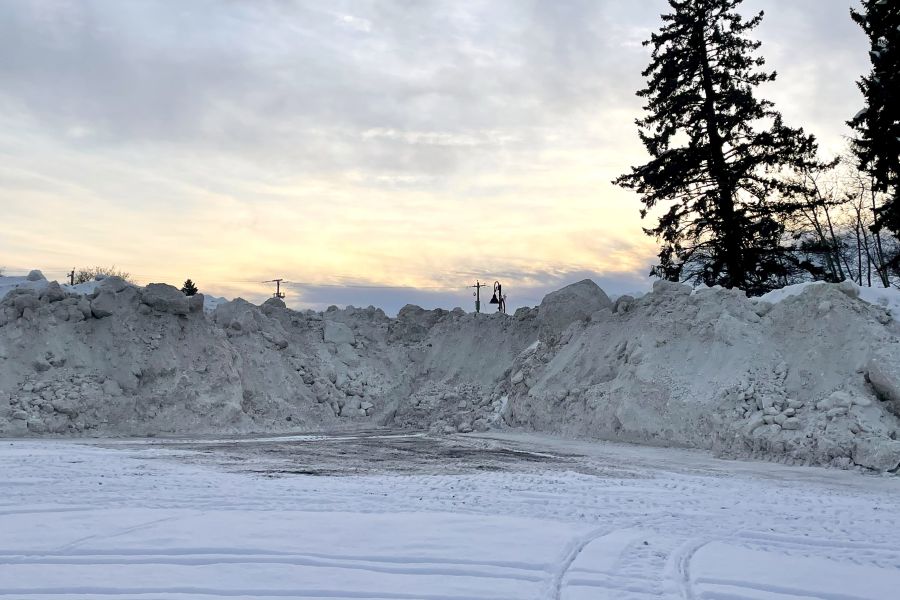
After the last few significant snowfalls, Whitecourt is living up to its name more than ever. Though snow isn’t how the Town got its name, it fits the joke. Many residents are used to how snow removal works within the community, but for those new or who need a refresher, here’s a breakdown of the pertinent information.
When the snow falls, the Town of Whitecourt’s first action is to lay sand. Once accumulation of the white stuff exceeds ten centimetres, plow trucks, and a grader get out to clear the high-priority routes, arterials, and collectors. An arterial road is a primary point that takes in traffic from collector roads. Arterial roads are typically divided into multiple lanes and see the most traffic.
Examples within Whitecourt include Dahl Drive, Mink Creek Road, 47 Street, 55 Avenue, Trading Post Trail, West Mountain Road (to the boundary), Kepler Street, Park Drive, Sunset Boulevard, Blueberry Drive, Beaver Drive, Chickadee Drive, 33 Street, and Whitecourt Avenue, to name a few. The roads mentioned above see a higher traffic volume as they feature multiple other road access points that bring motorists together. Along with several others, these roads are considered First Priority Routes and are cleared first when snow surpasses the ten-centimetre threshold.
Second priority routes are downtown streets directly near Central School or within the business core. Roads under this category include 53 Avenue, Legion Street, 51 Avenue (Friendship Park), and 52 Street (Millar Western). The third priority is the transit route. Pineview Road and the entrance to Eastlink Park are included here, while the remaining residential areas are Fourth Priority Routes. The numerous Park roads, Ravine Drive, Feero Drive, Baxter Crescent, Athabasca Drive, Windfall Drive, and much of the valley fall in this category of road clearing. The fifth and final priority is industrial and remaining residential. Flats Road, from the golf course entrance to the dog park, Riverside Road just beyond the tubing drop off, and the industrial park uptown are all included in this category.
Once crews complete the First Priority roads, they move onto Second Priority, followed by Third, Fourth, and Fifth. However, the sequence starts over if snow accumulates on First Priority roads before crews complete all five clearing designations. Though it can lead to frustration by residents dealing with snow-covered roads, keeping main roads with the highest traffic levels clear is their top priority for a good reason.
When snow falls, crews work all hours to keep roads safe through sand placement, plowing or snow removal. Certain areas are done alongside the priority routes, as deemed necessary, such as fire hydrants, access points for essential service areas or facilities, buildings and areas for public use, public parking lots, and locations used for bus loading. Homeowners with back lanes will know that snow removal typically only happens once conditions absolutely require it.
As for residents and what they are required to do, things may or may not change yearly. Depending on if there is a sidewalk on both sides of the road or not can dictate whether you get a year off from sidewalk duty or not. If Town crews push snow onto the sidewalks in front of or directly beside your home, you might be off the hook. To be sure, the Town of Whitecourt provides a map on their website that shows the directional movement for homeowners, so there’s no guessing.
If you are on sidewalk shovelling duty for the season, keep in mind that sidewalks in residential areas need to be clear of snow within 48 hours of the end of snowfall. They also need clearing to their full width. For business owners, sidewalks need shovelling within 24 hours of the end of a snowfall. Something else to keep in mind is that if residents come across a hazardous bit of sidewalk or roadway, call the town office (780-778-2273). No one can be everywhere at once, and a simple call can be the difference between a fast or slow fix. Giving the heads up can save another resident using the same sidewalk or roadway as you from dealing with a potentially serious situation. Per Policy 31-009, to help keep roads safe for all, residents are urged NOT to clear snow off their driveways into the street. Since residential streets are not cleared regularly, snow shovelled onto the roads can cause ruts and bumps, resulting in treacherous travel for motorists. Once crews pass by, if a windrow of greater than 30 centimetres is left at the end of your driveway, equipment will clear it within roughly two hours, states the Town of Whitecourt Frequently Asked Questions brochure on the town website. If crews miss yours, a call to the Town is a quick fix.
As for maintenance standards and how the Town checks road driveability, Policy 31-009 states, “road conditions will be evaluated using a front-wheel-drive sedan equipped with snow tires for residential and commercial streets, and a two-wheel-drive pickup with snow tires on industrial streets.” To learn more about snow clearing in the community and familiarize yourself with the do’s and don’ts, visit www.whitecourt.ca and search for Roads and Street Maintenance. Municipal staff frequently utilize the Town’s Facebook page to keep residents aware of snow clearing updates.







More Stories
Community spirit shines at large-scale youth baseball event
Birthday party chaos sung beautifully by Pumpjack Players’ youth in spring musical
Gearing up for another season of cars, cruising and camaraderie